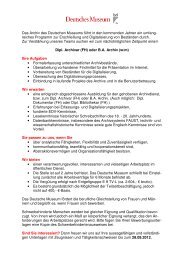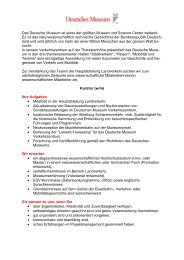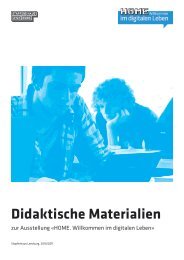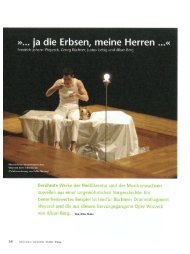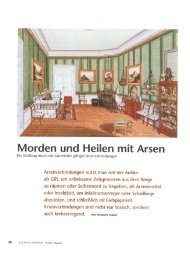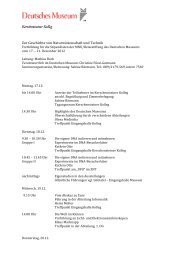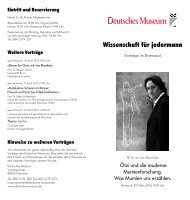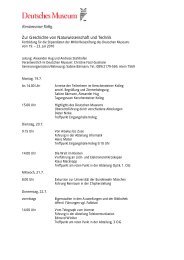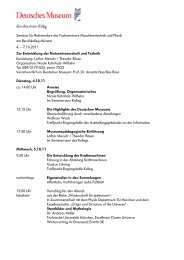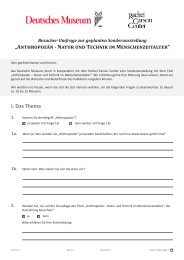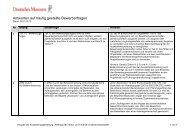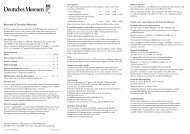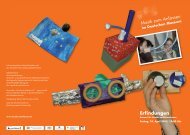Drehkolbenmotor DKM 54 - Deutsches Museum
Drehkolbenmotor DKM 54 - Deutsches Museum
Drehkolbenmotor DKM 54 - Deutsches Museum
Sie wollen auch ein ePaper? Erhöhen Sie die Reichweite Ihrer Titel.
YUMPU macht aus Druck-PDFs automatisch weboptimierte ePaper, die Google liebt.
MotorAlternativen<br />
<strong>Drehkolbenmotor</strong> <strong>DKM</strong> <strong>54</strong><br />
Der 19<strong>54</strong> gebaute <strong>Drehkolbenmotor</strong> <strong>DKM</strong> <strong>54</strong>,<br />
ist die erste funktionstüchtige Rotationskolbenmaschine.<br />
In herkömmlichen Hubkolbenmotoren bewegen<br />
sich die Zylinderkolben ruckartig auf und ab.<br />
Im <strong>DKM</strong> <strong>54</strong> hingegen drehen sich der dreieckigsähnliche Kolben<br />
und ein besonders geformtes Zylindergehäuse, um eine Achse.<br />
<strong>Drehkolbenmotor</strong>en zeichnen sich durch große Laufruhe aus.<br />
So können auch sehr hohe Drehzahlen erreicht werden, die<br />
für den Einsatz in Pumpen und Turbinen erforderlich sind.<br />
Um die dreidimensionalen Bewegungen der Motorkomponenten<br />
darstellen zu können entstehen neue Hilfsmittel.<br />
Das Zeichenhilfsgerät »Globus« - mit kugelförmig gestalteter<br />
Zeichenunterlage - ermöglicht die Herstellung der Konstruktionspläne<br />
für die Form des komplexen Kolbens und des Motorblocks.<br />
Mehr Informationen:<br />
Computerstation<br />
www.deutsches-museum-bonn.de<br />
3<br />
NSU Spider: Das erste<br />
Auto mit einem NSU-<br />
Wankelmotor (Baujahr 1963).<br />
Als Antrieb dient statt des<br />
geplanten <strong>Drehkolbenmotor</strong>s<br />
ein Kreiskolbenmotor.
MotorAlternativen<br />
AutoDidakt<br />
Felix Wankel (1902 – 1988) ist der Erfinder des <strong>Drehkolbenmotor</strong>s.<br />
Der gelernte Kaufmann und technische Autodidakt beginnt<br />
in den 1920er Jahren mit der Entwicklung von Motoren.<br />
In Lindau errichtet Wankel in den 1930er Jahren mit Hilfe des<br />
Reichsluftfahrtministeriums die Wankel-Versuchswerkstatt.<br />
Hier werden Steuerungsteile für Flugmotoren konstruiert.<br />
Aus der Wankel-Versuchswerkstatt wird 1951<br />
die Technische Forschungs- und Entwicklungsstelle.<br />
Hier tastet sich Wankel Schritt für Schritt an die<br />
optimale Form des <strong>Drehkolbenmotor</strong>s heran.<br />
Der erste Prototyp ist 19<strong>54</strong> funktionsfähig<br />
und besteht zwei Jahre später seine Feuerprobe:<br />
den »Hundertstundenlauf« bei der NSU-Werke AG in Neckarsulm.<br />
Auf der Tagung des Vereins Deutscher Ingenieure (VDI)<br />
stellt Wankel 1960 seinen Motor in München vor.<br />
Mehr Informationen:<br />
Computerstation<br />
www.deutsches-museum-bonn.de<br />
MotorGeschichten<br />
Wankels revolutionärer <strong>Drehkolbenmotor</strong> wird vor der Fertigung<br />
in Großserie modifiziert und durch die Entscheidung für ein<br />
starres Zylindergehäuse zum Kreiskolbenmotor.<br />
Der NSU Spider erscheint 1963 als erstes Auto mit diesem Motor.<br />
Ein weiteres Modell mit »Wankel-Motor«, der Ro 80, läuft<br />
bis 1977 bei den NSU-Werken etwa 38.000 mal vom Band.<br />
Vor allem der hohe Benzinverbrauch, aber auch Probleme<br />
mit den Dichtungen, die Ölkrise Anfang der siebziger Jahre,<br />
strengere Abgasnormen und die Übernahme von NSU durch VW<br />
bringen das Ende des Wankel-Motors in Deutschland.<br />
Bis 1972 nehmen Interessenten in dreißig<br />
Ländern Lizenzen auf dieses neue Motorprinzip.<br />
Doch nur noch Mazda entwickelt den Wankelmotor weiter.<br />
Er wird sowohl in Serienautos, als auch im Rennsport eingesetzt.
Alternative motive power<br />
<strong>DKM</strong> <strong>54</strong> rotary piston engine Automotive autodidact Engine history<br />
The <strong>DKM</strong> <strong>54</strong>, built in 19<strong>54</strong>, was the first<br />
functioning rotary-piston engine.<br />
In a conventional reciprocating engine,<br />
pistons move back and forth in cylinders.<br />
In the <strong>DKM</strong> <strong>54</strong>, on the other hand, a<br />
roughly triangular piston rotated<br />
inside a specially shaped housing<br />
which itself rotated evenly about its axis.<br />
For this reason, rotary-piston engines<br />
are very smooth-running.<br />
They can also attain very high speeds,<br />
so can drive a pump<br />
or turbine impeller without gearing.<br />
In order to envisage the motion<br />
of the engine parts, new mechanical aids<br />
werealso developed.<br />
The ‘Globus’, for example,<br />
plotted on a spherical surface.<br />
More information:<br />
Computer Station<br />
www.deutsches-museum-bonn.de<br />
Felix Wankel (1902–1988) was the inventor<br />
of the rotary-piston engine. Having studied<br />
business management, he was self-taught in<br />
technical matters; he began designing<br />
engines in his twenties.<br />
In the 1930s he set up the Wankel Experimental<br />
Workshops in Lindau on Lake<br />
Constance, with the help of the Imperial<br />
Ministry of Aviation; there he designed<br />
control components for aero engines.<br />
In 1951 his workshop became the Technical<br />
Research and Development Unit.<br />
Gradually Wankel approached the optimum<br />
form of his rotary-piston engine –<br />
the first functioning prototype was<br />
produced in 19<strong>54</strong>.<br />
Two years later it passed the acid test: the<br />
100-hours run at NSU in Neckarsulm to<br />
the north of Stuttgart.<br />
Wankel presented his engine at the 1960<br />
convention of the Institute of German<br />
Engineers (VDI) in Munich.<br />
When Wankel’s revolutionary engine was<br />
mass-produced there was a technical<br />
compromise: the housing remained fixed.<br />
The NSU Spider appeared in 1963,<br />
the first car with a rotary-piston engine.<br />
Some 38 000 of its successor the Ro 80<br />
were produced at NSU up to 1977.<br />
The high fuel consumption, coupled with<br />
the fuel crisis in the early seventies, problems<br />
with the piston seals, stricter exhaust<br />
emission regulations, and the takeover of<br />
NSU by Volkswagen, brought about the<br />
end of the rotary-piston engine in<br />
Germany.<br />
By 1972, companies in thirty countries had<br />
acquired licences to work on this revolutionary<br />
type of engine. However, only Mazda<br />
developed the Wankel engine further.<br />
It was used in series production and in<br />
motor racing.<br />
Caption<br />
The NSU Spider (1963) was<br />
the first car to be powered<br />
by a Wankel engine.<br />
The original design was<br />
modified in the practical<br />
implementation.<br />
2



